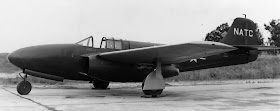The first Bell Aircraft Navy fighter was, of course, the XFL-1. I've written a monograph on it for Steve Ginter's Naval Fighters series. It's pretty comprehensive if I do say so myself and addresses some common misconceptions about the Airabonita. It's available from Amazon and others.
Some have written that the P-59A was the F2L (more on that in a minute). The Navy History Center lists two F2Ls with BuNos, the XF2L (90060 and 90061) and the F2L-1K (91102 and 91103). The XF2L is stated to be canceled P-63s*, which sort of makes sense because those Bureau Numbers were used to contract for the L-39s, swept-wing configured P-63s. (For more on the L-39s, see http://thanlont.blogspot.com/2011/04/bell-l-39-wing-sweep-evaluation.html)
The F2L-1Ks were postwar modifications of Army P-39Qs as drones. These were flown at NAS Cape May, New Jersey. I don't have any pictures yet. A Navy History Center list includes the crash of an F2L in 1946. It turns out that there were two crashes, both F2L-1Ks being flown from the cockpit. BuNo 91102 had an engine failure in the pattern at Cape May and was dead-sticked to a wheels up landing. While operating from NAAS Chincoteague, VA, BuNo 91103 apparently had a brake lock and rudder jam after the disconnect in flight of the remote control system and went off the runway during the landing. Both airplanes were strikes.
These F2L-1Ks may have been preceded by an XTDL-1 (another P-39 modification) that wasn't given a Bureau Number, which would be rare but not unknown or they may have originally designated or intended to be designated TDL, which makes more sense than F2L, since the airplanes were to be used operationally as target drones, not fighters. Although some references list as many as seven were created, it appears more likely that only two P-39s were converted and the remainder cancelled.
Back to the P-59A. In 1941, when the Army asked Bell to design and develop its first jet airplane, Bell had a contract with the Army for the XP-59. It was to be powered by a P&W R-2800 driving a contrarotating pusher propeller. It had reached the mockup stage and was also being proposed to the Navy.
Photo provided by Niagara Aerospace Museum
Note the inlet in the nose for cooling air to the R-2800 and the cannon or machine gun barrels at the front of the tail booms. The stand reads Proposed Navy VF Fighter Spec. SD 112.18. F2L does not appear, although of course this would have been its designation if the Navy had contracted for it.
Some of the mockup pictures include the words "Proposed Navy Fighter" and in others, like this one, Navy Fighter has been carefully erased.
Photo provided by Niagara Aerospace Museum
Lest one think that it was pictures of the mockup of the Army airplane with captions added for the Navy's benefit, a picture of the mockup's cockpit shows the presence of a chart board, which was a Navy requirement.
When the Army contracted with Bell for a jet airplane in December 1941, it did so with the designation XP-59A, presumably using the same contract as the now unwanted XP-59. It was, of course, a completely different configuration. The objective was to add a layer of secrecy to the program.
The Navy obtained two YP-59As and three P-59Bs for its evaluation and pilot familiarization. This is the first Navy YP-59A, as received in late 1943.
It was given BuNo 63960. It was subsequently repainted in the Navy tri-color paint scheme. Note that it does not have guns.
At some point after that, it was brought up to production P-59 standard (square wing tips, ventral fin, etc.) and repainted again, this time with yellow wings for some reason.
Tom Doll collection via Rich Dann
Note, however, that the designation marked on it is "YP59-A".
One theory behind a Navy designation of YF2L for its YP-59A is the existence of the F2L-1Ks to provide misdirection. This almost certainly wasn't the case given that the Navy's drone P-39 program was later in time. Somewhat more plausible is that the YF2L designation was a subterfuge equivalent to the Army's use of the P-59A designation since the XP-59 had been proposed to the Navy. If so, the Navy doesn't appear to have used it in any documents found to date. Its P-59s are always referred to as P-59s.
The Navy also kept pretty good track of assigned designations so it seems likely that the post-war contract for P-39 drones would have used the designation F3L if F2L had been used in the early 1940s for the Airacomet, unless the designation was not a subterfuge but the program considered so secret that the designation was never revealed...
*Bell reportedly proposed a carrier-based P-63. It's conceivable that these Bureau Numbers, originally assigned to an RY-3 Privateer contract, might have been intended for that evaluation before they were used for the L-39s. However, they seem to be too high for that possibility.








No comments:
Post a Comment